Evaluation Method for Rock Burst Hazards in Strip Filling of Working Faces in Deep Coal Mines
Abstract
:1. Introduction
2. Impact Hazard Identification Criteria
- Filling rate ηf = 0 represents the working face being unfilled, i.e., using the caving method to manage the goaf roof. If the total stress of the working face is lower than the weak impact risk line, it indicates that the overall level of the support pressure of the strip working face is lower than the minimum stress value that induces impact, and the strip working face has no impact risk. At this time, although filling mining can slow down the dynamic pressure manifestation of the coal body in front of the working face, it has no essential impact on the hazard level of the strip working face, as shown in curve 1 in Figure 1.
- For strip working faces with a medium or higher hazard level using the caving method, filling mining can significantly reduce the impact risk of the working face, as shown in curves 2, 3, and 4 in Figure 1. When the filling rate ηf increases, the intensity and range of fracture motion of low-level rock beams decrease, resulting in a decrease in dynamic stress and a decrease in the impact risk. There are one or more critical filling rates. When the filling rate is greater than the critical filling rate, the impact risk is reduced to weak or below. This indicates that filling mining effectively reduces the impact risk in strip working faces. When the filling rate is less than the critical filling rate, the total stress is still greater than the critical stress for impact to occur. The impact risk after filling is still moderate or above. This indicates that the use of filling mining as a single measure cannot effectively eliminate the impact risk. In this case, other anti-impact measures should also be carried out.
- Curve 5 in Figure 1 indicates that regardless of filling or not, the impact risk of the strip working face is always strong. The possibility of a rock burst is extremely high, which indicates the working face is unsafe and unable to be worked upon.
3. Impact Hazard Evaluation Method
3.1. Indicators and Membership Functions Determination
3.1.1. Stress State of Coal
- 1.
- Coal body
- 2.
- Strip coal pillar
3.1.2. Elastic Energy Index of Coal Seam
3.2. Impact Hazard Level Classification
4. Case Investigations
4.1. Engineering Overview
4.2. Impact Hazard Evaluation
4.2.1. Overall Impact Risk
4.2.2. Local Impact Risk
- 1.
- Vertical stress of mining roadway
- 2.
- Impact risk area division
5. Discussions
6. Conclusions
Author Contributions
Funding
Data Availability Statement
Acknowledgments
Conflicts of Interest
References
- Xie, H.P.; Wang, J.H.; Ren, H.W.; Liu, J.Z.; Zhou, H.W.; Wu, G.; Ren, S.H. New ideas of coal revolution and layout of coal science and technology development. J. Chin. Coal Soc. 2018, 43, 1187–1197. [Google Scholar]
- Kang, H.P.; Gao, F.Q.; Xu, G.; Ren, H.W. Mechanical behaviors of coal measures and ground control technologies for China’s deep coal mines—A review. J. Rock. Mech. Geotech. 2022, 15, 37–65. [Google Scholar] [CrossRef]
- Jin, Y.X.; Geng, J.; Lv, C.; Chi, Y.; Zhao, T.D. A methodology for equipment condition simulation and maintenance threshold optimization oriented to the influence of multiple events. Reliab. Eng. Syst. Safe 2023, 229, 108879. [Google Scholar] [CrossRef]
- Liu, X.S.; Fan, D.Y.; Tan, Y.L.; Ning, J.G.; Song, S.L.; Wang, H.L.; Li, X.B. New detecting method on the connecting fractured zone above the coal face and a case study. Rock Mech. Rock Eng. 2021, 54, 4379–4391. [Google Scholar] [CrossRef]
- Gao, C.J.; Huang, D.M.; Chang, X.K.; Xi, H. Risk analysis and extension assessment for the stability of surrounding rock in deep coal roadway. Int. J. Environ. Res. Pub. Health 2019, 16, 4752. [Google Scholar] [CrossRef]
- Qi, Q.X.; Pan, Y.F.; Shu, L.Y.; Li, H.Y.; Jiang, D.Y.; Zhao, S.K.; Zou, Y.H.; Pan, J.F.; Wang, K.J.; Li, H.T. Theory and technical framework of prevention and control with different sources in multi-scales for coal and rock dynamic disasters in deep mining of coal mines. J. Chin. Coal Soc. 2018, 43, 1801–1810. [Google Scholar]
- Liu, X.S.; Fan, D.Y.; Tan, Y.L.; Song, S.L.; Li, X.F.; Ning, J.G.; Gu, Q.H.; Ma, Q. Failure evolution and instability mechanism of surrounding rock for close-distance parallel chambers with super-large section in deep coal mines. Int. J. Geomech. 2021, 21, 04021049. [Google Scholar] [CrossRef]
- Zhang, A.L.; Zhang, R.; Gao, M.Z.; Zhang, Z.T.; Jia, Z.Q.; Zhang, Z.P.; Zha, E.S. Failure behavior and damage characteristics of coal at different depths under triaxial unloading based on acoustic emission. Energies 2020, 13, 4451. [Google Scholar] [CrossRef]
- Xie, H.P.; Lu, J.; Li, C.B.; Li, M.H.; Gao, M.Z. Experimental study on the mechanical and failure behaviors of deep rock subjected to true triaxial stress: A review. Int. J. Min. Sci. Technol. 2023, 32, 915–950. [Google Scholar] [CrossRef]
- Zhang, J.X.; Tu, S.H.; Cao, Y.J.; Tan, Y.L.; Xin, H.Q.; Pang, J.L. Coal gangue intelligent separation and backfilling technology and its engineering application in underground coal mine. J. Chin. Univ. Min. Technol. 2021, 50, 417–430. [Google Scholar]
- Chen, S.J.; Wang, H.L.; Wang, H.Y.; Guo, W.J.; Li, X.S. Strip coal pillar design based on estimated surface subsidence in eastern China. Rock Mech. Rock Eng. 2016, 49, 3829–3838. [Google Scholar]
- Jiang, B.Y.; Ji, H.G.; Fu, L.; Gu, S.T.; Zou, T.; Lu, J.X. Research on evaluation index and application of rockburst risk in deep strip mining. Shock Vib. 2020, 2020, 8824323. [Google Scholar] [CrossRef]
- Jiang, F.X.; Wen, J.L.; Bai, W.S.; Wang, G.L.; Li, M. Rock burst risk in surrounding abscission layer of overlying high key strata in deep strip mining mines. J. Chin. Univ. Min. Technol. 2018, 47, 40–47. [Google Scholar]
- Fang, X.Q.; Dou, L.M.; Liu, J.C.; Peng, L.Z.; Mu, Z.L. Manage of rock burst in mine with great mining depth partial extraction and strong roof face. J. Chin. Univ. Min. Technol. 2006, 35, 602–606. [Google Scholar]
- Feng, G.M.; Sun, C.D.; Wang, C.Z.; Zhou, Z. Research on goaf filling methods with super high-water material. J. Chin. Univ. Min. Technol. 2010, 35, 1963–1968. [Google Scholar]
- Jiang, J.Q.; Wu, Q.S.; Zhang, P.P.; Ma, F.W. Dynamic disaster control of backfill mining under supper-thick magmatic rocks. Metal. Min. 2015, 469, 139–142. [Google Scholar]
- He, J.; Dou, L.M.; Cai, W.; Li, Z.H.; Ding, Y.H. Mechanism of dynamic and static combined load inducing rock burst in thin coal seam. J. Chin. Coal Soc. 2014, 39, 2177–2182. [Google Scholar]
- Smoliński, A.; Malashkevych, D.; Petlovanyi, M.; Rysbekov, K.; Rysbekov, K.; Lozynskyi, V.; Sai, K. Research into impact of leaving waste rocks in the mined-out space on the geomechanical state of the rock mass surrounding the longwall face. Energies 2022, 15, 9522. [Google Scholar] [CrossRef]
- Malashkevych, D.; Petlovanyi, M.; Sai, K.; Serhii, Z. Research into the coal quality with a new selective mining technology of the waste rock accumulation in the mined-out area. Min. Min. Depos. 2022, 16, 103–114. [Google Scholar] [CrossRef]
- Lan, H.; Chen, D.K.; Mao, D.B. Current status of deep mining and disaster prevention in China. Coal Sci. Technol. 2016, 44, 39–46. [Google Scholar]
- Jiang, F.X.; Shu, C.X.; Wang, C.W. Impact risk appraisal of stope working faces based on stress superimposition. Chin. J. Rock Mech. Eng. 2015, 34, 2428–2435. [Google Scholar]
- Zhang, K.Z.; Xia, J.M. Weight-variable identification model of comprehensive evaluation on burst liability of coal. Chin. J. Rock Mech. Eng. 2004, 23, 3480–3483. [Google Scholar]
- Tan, Y.L.; Guo, W.Y.; Xin, H.Q.; Zhao, T.B.; Yu, F.H.; Liu, X.S. Key technology of rock burst monitoring and control in deep coal mining. J. Chin. Coal Soc. 2019, 44, 160–172. [Google Scholar]
- Mutke, G.; Dubiński, J.; Lurka, A. New criteria to assess seismic and rock burst hazard in coal mines. Arch. Min. Sci. 2015, 60, 743–760. [Google Scholar]
- China National Mine Safety Adminstration. Detailed Rules for Prevention and Control of Coal Mine Rock Burst; China Coal Industry Publishing House: Beijing, China, 2018. [Google Scholar]
- Xu, J.; Jiang, J.; Xu, N.; Liu, Q.; Gao, Y. A new energy index for evaluating the tendency of rockburst and its engineering application. Eng. Geol. 2017, 230, 46–54. [Google Scholar] [CrossRef]
- Gong, F.; Yan, J.; Li, X.; Luo, S. A peak-strength strain energy storage index for rock burst proneness of rock materials. Int. J. Rock Mech. Min. Sci. 2019, 117, 76–89. [Google Scholar] [CrossRef]
- Jiang, F.X.; Wang, J.C.; Sun, G.J.; Zhu, S.T. Engineering criterion of gob-side entry rock burst hazard in deep mining. J. Chin. Coal Soc. 2015, 40, 1729–1736. [Google Scholar]
- Yang, G.Y.; Jiang, F.X.; Li, L.; Li, N.L.; Liu, P. Engineering criterion study on coal mining rock burst hazard. J. Min. Saf. Eng. 2018, 35, 1200–1207. [Google Scholar]
- Gong, F.; Yan, J.; Luo, S.; Li, X. Investigation on the Linear Energy Storage and Dissipation Laws of Rock Materials Under Uniaxial Compression. Rock Mech. Rock Eng. 2019, 52, 4237–4255. [Google Scholar] [CrossRef]
- Zhang, S.P.; Zhao, J.; Li, S.D.; Zhou, T.; Cui, X.C.; Zhang, D.; Liang, J.Z.; Wang, G.A.; Zhu, S.T.; Sun, B. Study on impact risk assessment of isolated coal mass in roadway of thick coal seam in deep mine. J. Safe Sci. Technol. 2022, 18, 70–77. [Google Scholar]
- Fan, D.Y.; Liu, X.S.; Tan, Y.L.; Li, X.B.; Purev, L. Instability energy mechanism of super-large section crossing chambers in deep coal mines. Int. J. Min. Sci. Technol. 2022, 32, 1075–1086. [Google Scholar] [CrossRef]
- Wen, J.L.; Li, H.S.; Jiang, F.X.; Yu, Z.X.; Ma, H.T.; Yang, X.L. Rock burst risk evaluation based on equivalent surrounding rock strength. Int. J. Min. Sci. Technol. 2019, 29, 571–576. [Google Scholar] [CrossRef]
- Yang, H.Z.; Guo, Z.P.; Chen, D.Z.; Chen, D.Z.; Wang, C.; Zhang, F.Y.; Du, Z.W. Study on reasonable roadway position of working face under strip coal pillar in rock burst mine. Shock Vib. 2020, 2020, 8832791. [Google Scholar] [CrossRef]
- Qiu, P.Q.; Ning, J.G.; Wang, J.; Hu, S.C.; Li, Z. Mitigating rock burst hazard in deep coal mines insight from dredging concentrated stress: A case study. Tunn. Undergr. Space Technol. 2021, 115, 104060. [Google Scholar] [CrossRef]
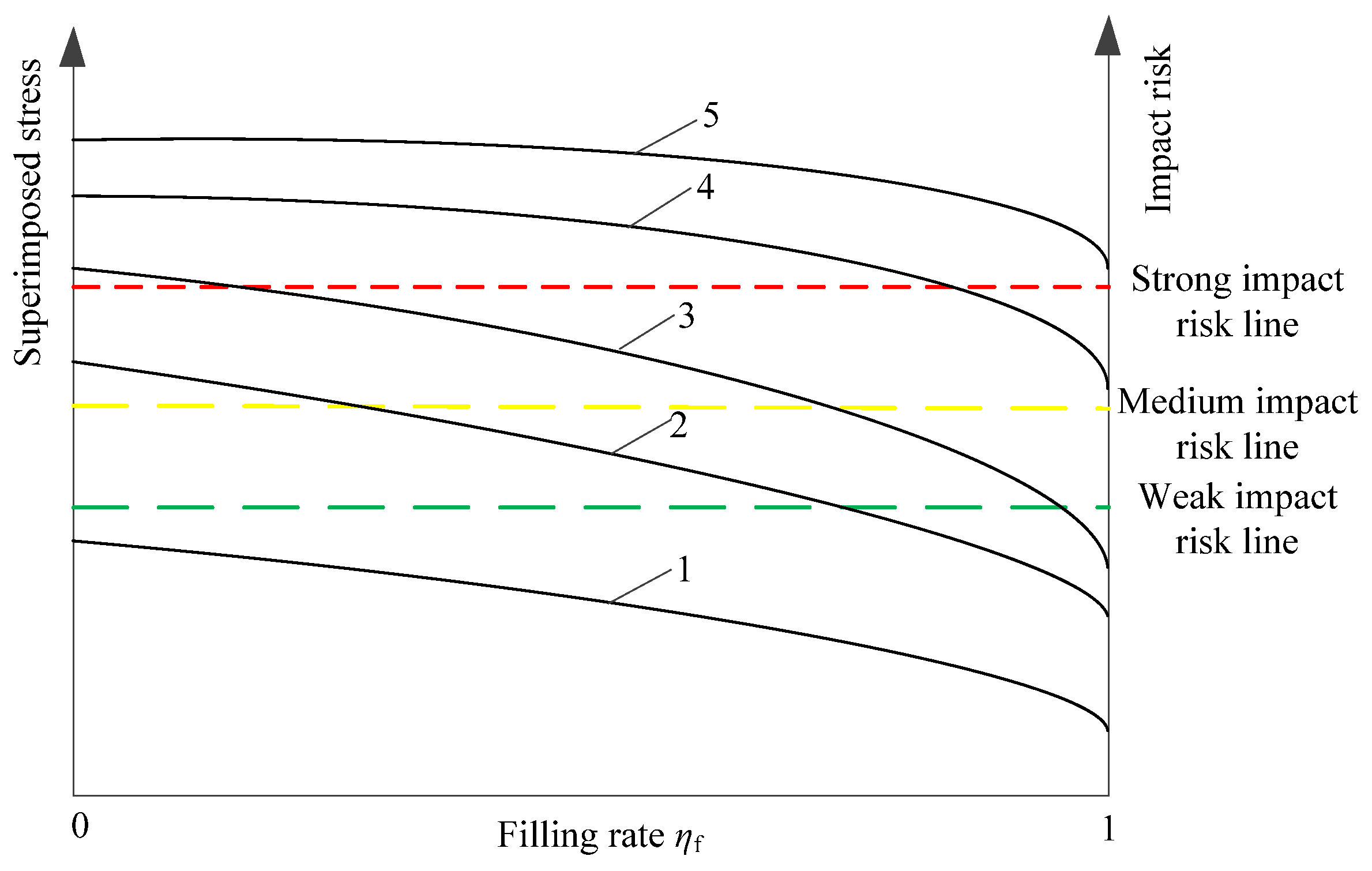

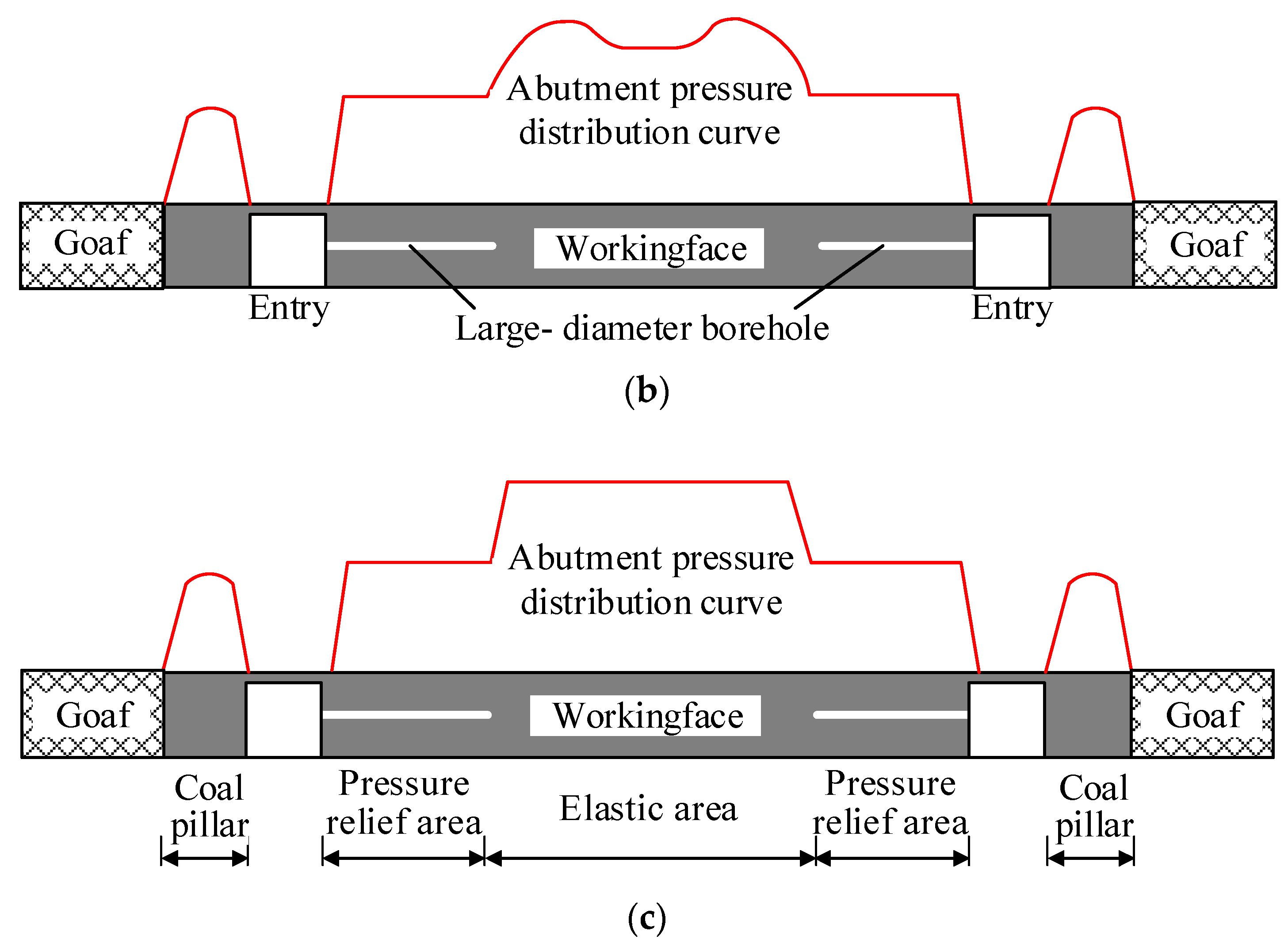
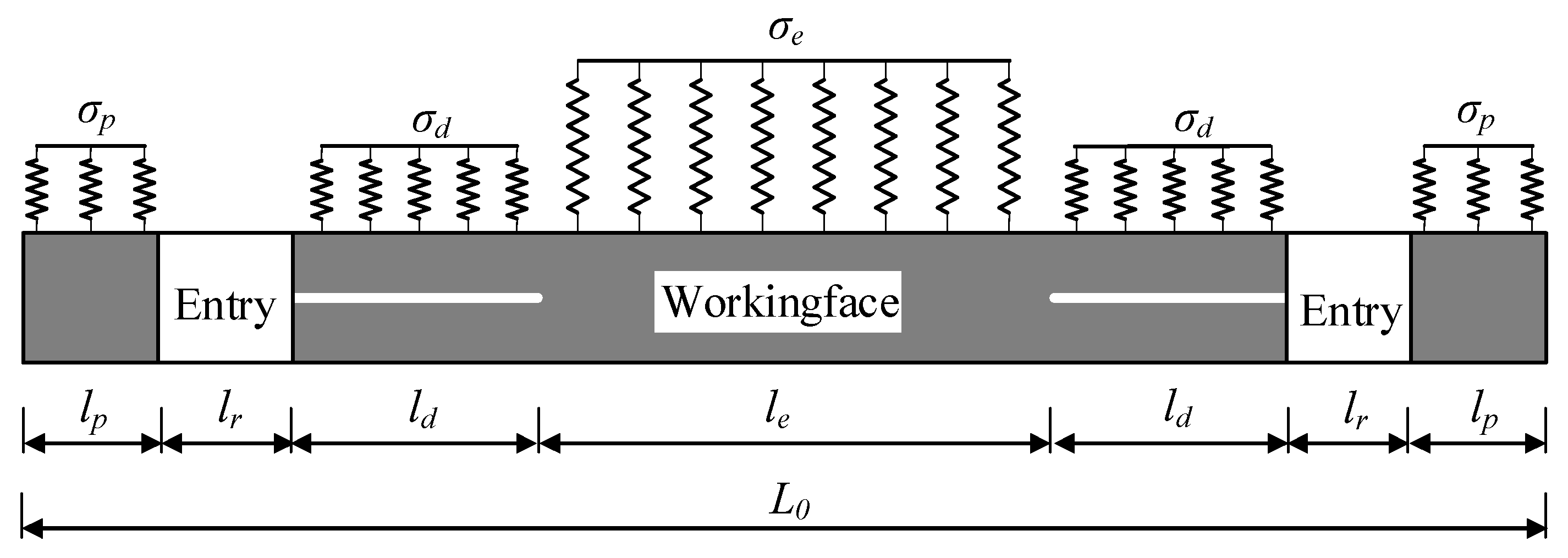
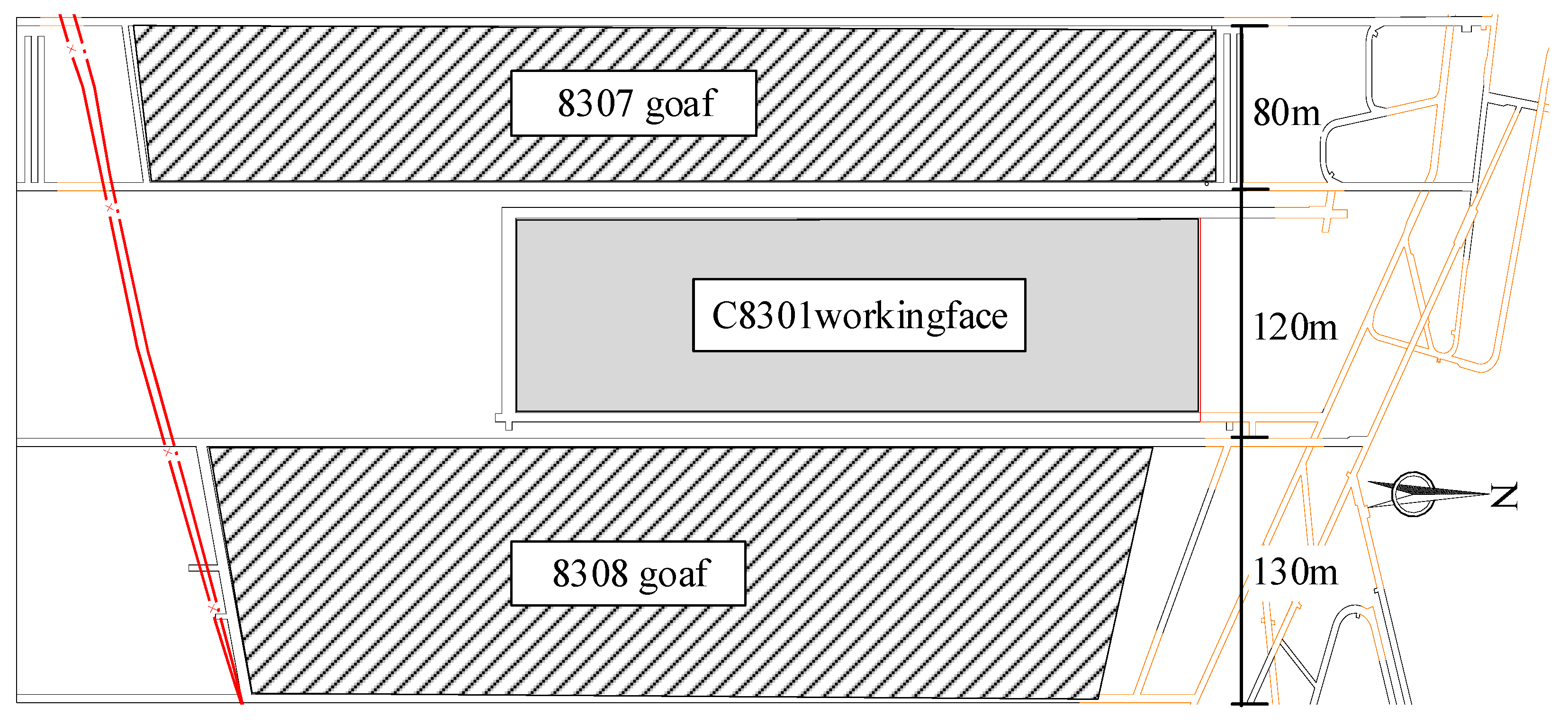

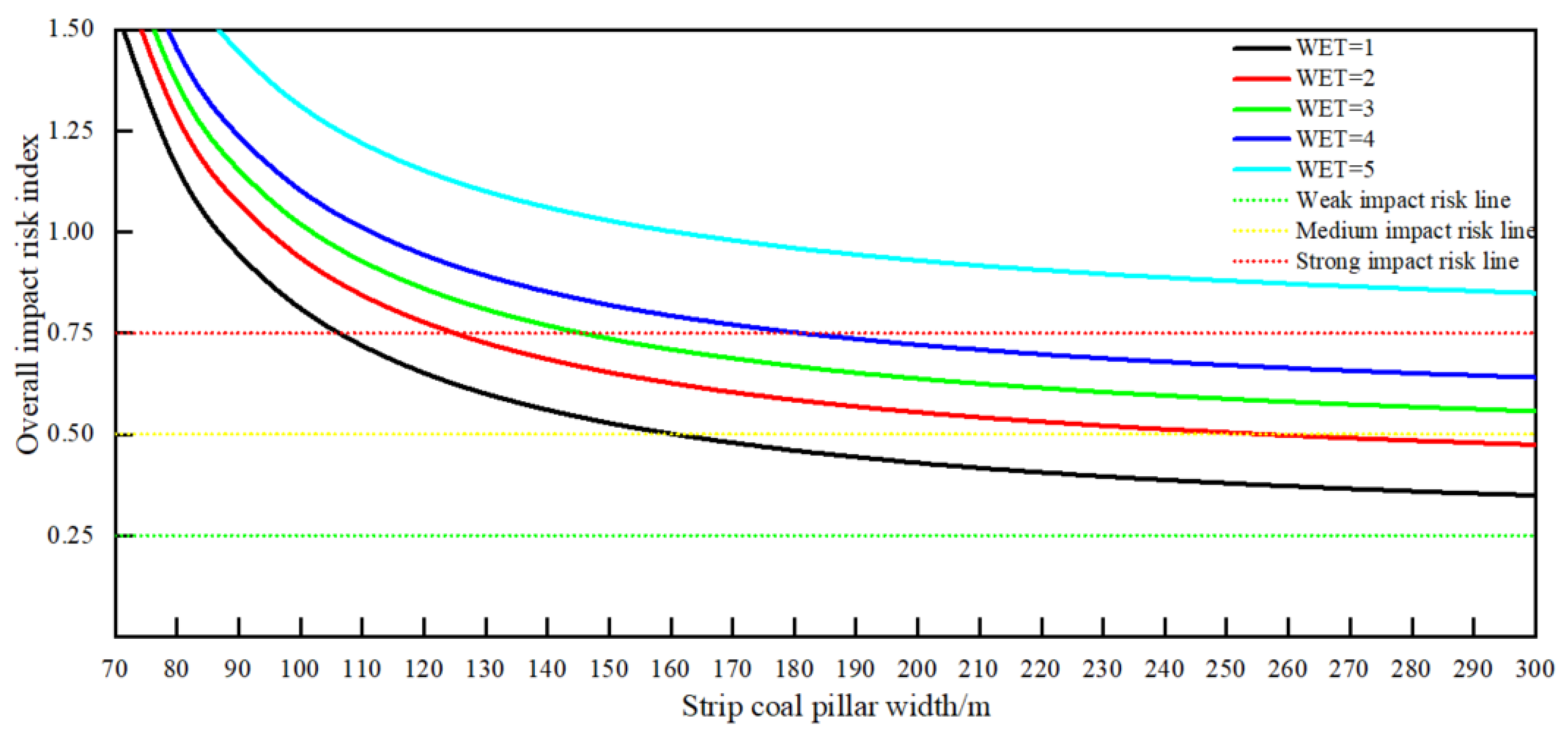
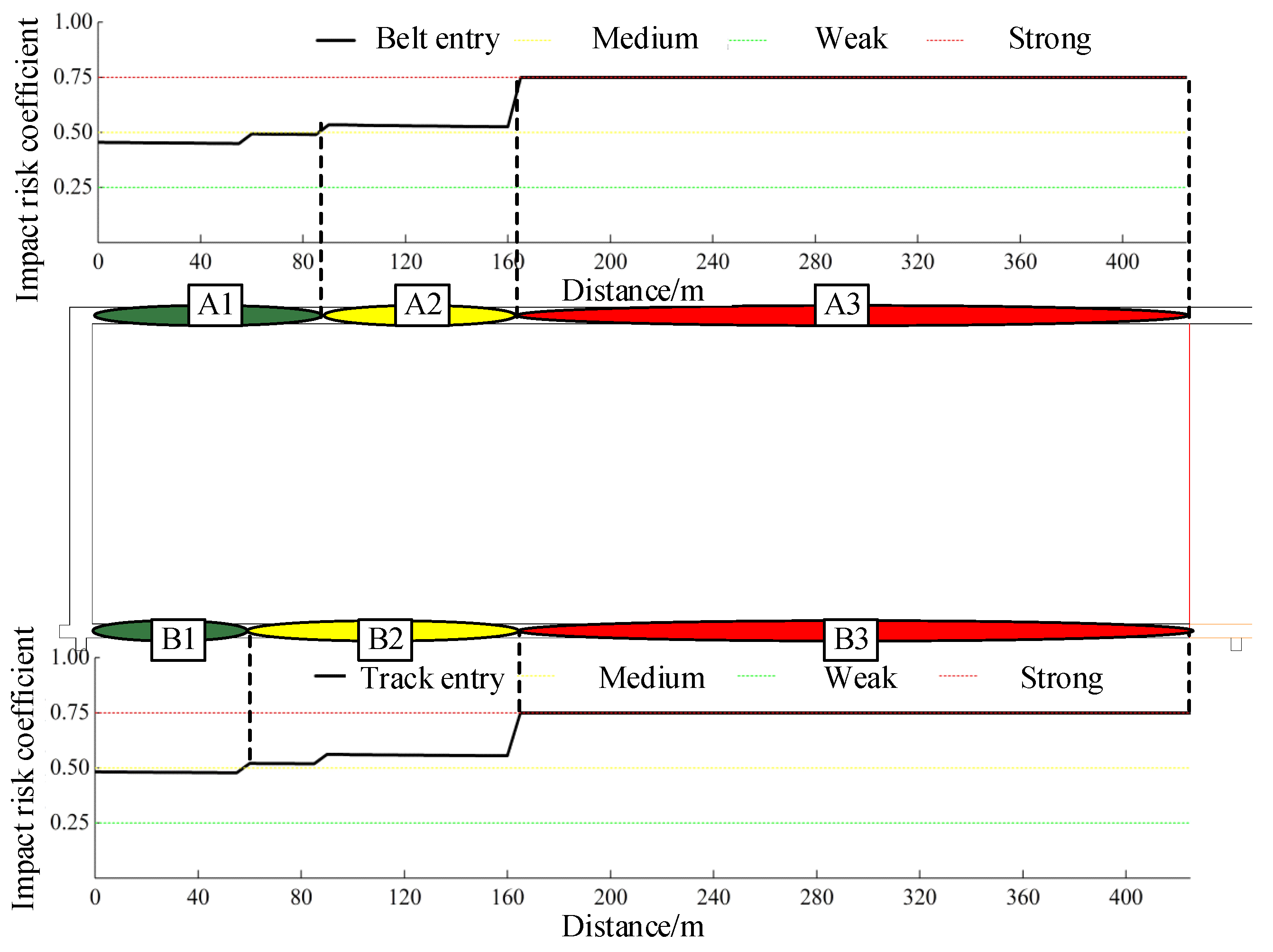
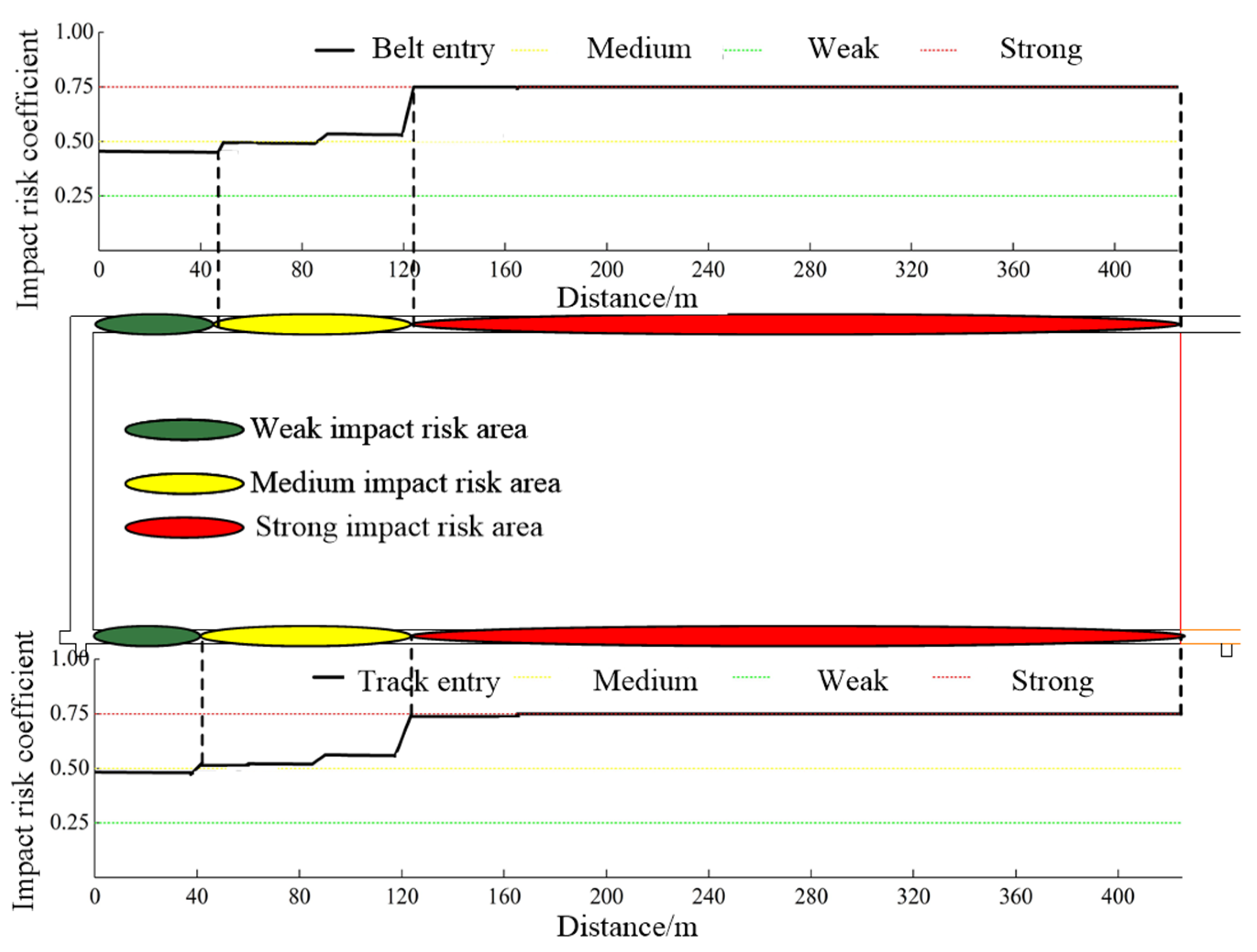
| Impact Hazard Level | Impact Risk Index U1/U2 Values |
|---|---|
| No impact risk | [0, 0.25) |
| Weak impact risk | [0.25, 0.5) |
| Medium impact risk | [0.5, 0.75) |
| Strong impact risk | [0.75, 1] |
| Influencing Factors | Stress Increment Concentration | Influence Range/m |
|---|---|---|
| Folds | 0.1 | 0, 424 |
| Initial fracture | 0.1 | 60, 90 |
| Working face square | 0.2 | 90, 160 |
| Two working face square | 0.5 | 160, 300 |
| Three working face square | 0.7 | 300, 380 |
| Distance from Open-Off Cut/m | Influencing Factors | Impact Risk | ||
|---|---|---|---|---|
| Belt entry | A1 | 0~90 | Self-weight stress, folds, initial pressure | Weak |
| A2 | 90~160 | Self-weight stress, folds, working face square | Medium | |
| A3 | 160~424 | Self-weight stress, folds, two working face square, three working face square | Strong | |
| Track entry | B1 | 0~60 | Self-weight stress, folds, initial pressure | Weak |
| B2 | 60~160 | Self-weight stress, folds, working face square | Medium | |
| B3 | 160~424 | Self-weight stress, folds, two working face square, three working face square | Strong | |
Disclaimer/Publisher’s Note: The statements, opinions and data contained in all publications are solely those of the individual author(s) and contributor(s) and not of MDPI and/or the editor(s). MDPI and/or the editor(s) disclaim responsibility for any injury to people or property resulting from any ideas, methods, instructions or products referred to in the content. |
© 2023 by the authors. Licensee MDPI, Basel, Switzerland. This article is an open access article distributed under the terms and conditions of the Creative Commons Attribution (CC BY) license (https://creativecommons.org/licenses/by/4.0/).
Share and Cite
Chen, Y.; Sun, X.; Zhang, X.; Gu, P.; Li, G.; Yang, S.; Fan, D.; Liu, C.; Liu, X. Evaluation Method for Rock Burst Hazards in Strip Filling of Working Faces in Deep Coal Mines. Appl. Sci. 2023, 13, 10452. https://doi.org/10.3390/app131810452
Chen Y, Sun X, Zhang X, Gu P, Li G, Yang S, Fan D, Liu C, Liu X. Evaluation Method for Rock Burst Hazards in Strip Filling of Working Faces in Deep Coal Mines. Applied Sciences. 2023; 13(18):10452. https://doi.org/10.3390/app131810452
Chicago/Turabian StyleChen, Yang, Xikui Sun, Xiufeng Zhang, Peng Gu, Guoying Li, Shenglong Yang, Deyuan Fan, Chuancheng Liu, and Xuesheng Liu. 2023. "Evaluation Method for Rock Burst Hazards in Strip Filling of Working Faces in Deep Coal Mines" Applied Sciences 13, no. 18: 10452. https://doi.org/10.3390/app131810452
APA StyleChen, Y., Sun, X., Zhang, X., Gu, P., Li, G., Yang, S., Fan, D., Liu, C., & Liu, X. (2023). Evaluation Method for Rock Burst Hazards in Strip Filling of Working Faces in Deep Coal Mines. Applied Sciences, 13(18), 10452. https://doi.org/10.3390/app131810452








